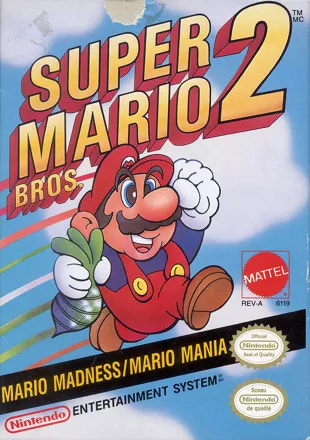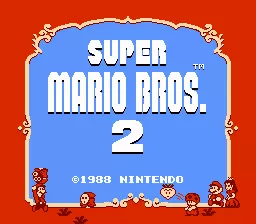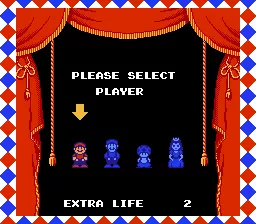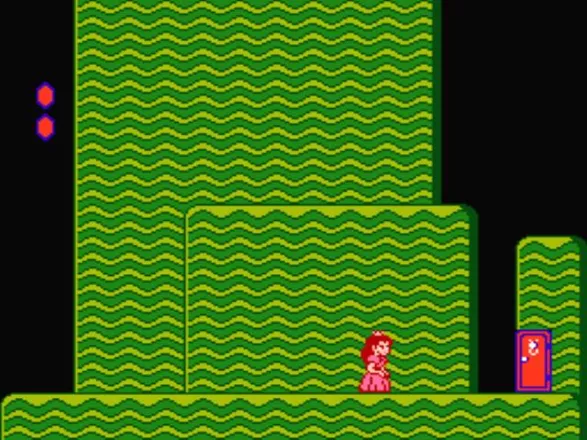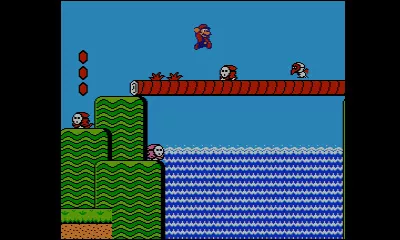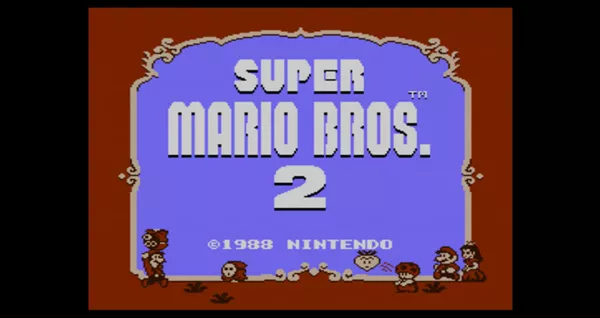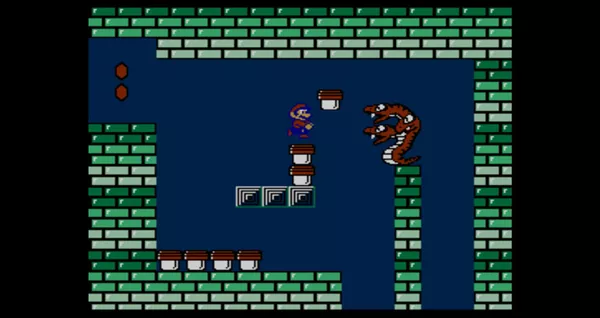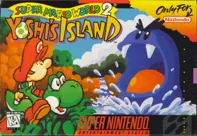Super Mario Bros. 2
-
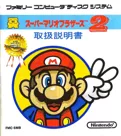 Super Mario Bros. 2
(1986 on
NES, 2004 on
Game Boy Advance, 2007 on
Wii...)
Super Mario Bros. 2
(1986 on
NES, 2004 on
Game Boy Advance, 2007 on
Wii...)
Description official descriptions
This release of Super Mario Bros. 2 is completely different from its original Japanese counterpart, originating in the West and being in fact a version of Yume Kōjō: Dokidoki Panic with a different storyline and protagonists swapped for Mario and his friends.
One night Mario has a strange dream, where he opens a door to another world filled with even stranger creatures and lands than those in his last adventure against Bowser. Amazingly, the next day, Mario, Luigi, Toad, and the Princess stumble upon a cave, which leads to the world that was in Mario's dream.
Subcon, the land of dreams, is under an evil spell thanks to Wart, so Mario and the gang must save the day. New creatures to defeat and plenty of nasty surprises await.
Choose from the four characters, each differing in speed and jumping ability, and head on through 7 levels each filled with puzzles, bosses, bonus coins, the always helpful mushroom, and invincible star, plus bombs and magic potions. After each level, depending on the coins you collect, you can use them in the bonus game to collect extra lives.
Spellings
- Super Mario Brothers 2 - Alternate spelling
- スーパーマリオUSA - Japanese spelling
Groups +
Screenshots
Promos
Videos
Add Trailer or Gameplay Video +1 point
See any errors or missing info for this game?
You can submit a correction, contribute trivia, add to a game group, add a related site or alternate title.
Credits (NES version)
15 People
| Executive Producer | |
| Producer | |
| Director | |
| Assistant Director | |
| Character Designer | |
| Title Designer | |
| Course Designers | |
| Motion Designers | |
| Programmers | |
| Sound Composer |
Reviews
Critics
Average score: 86% (based on 39 ratings)
Players
Average score: 4.0 out of 5 (based on 196 ratings with 5 reviews)
Great game, but why did Nintendo keep us in the dark
The Good
A very good game, lots of sound, easy to beat. Good graphically and sounding. A good original and a good keeper.
The Bad
This game is a fake Mario game, as it is originally Doki Doki Panic in Japan, which is a totally different story and concept. The Japanese game is much harder, as you can not run and go through some of the loopholes there are in the American version. Every player has to beat the game, not just 4 beating it once.
Nintendo kept us in the dark about the fact that they released Super Mario 2 in 1986 when it was released as a Mario game. They kept it in Japan because it was too hard for us. I think it was a little too late when they compiled it in Super Mario All-Stars.
The Bottom Line
Its good, dont let my feelings towards Nintendo's Japan Vs. American marketing and their point of view that Japanese kids are smarter get in the way.
NES · by Scott G (765) · 2006
If loving SMB2 is wrong, I don't want to be right.
The Good
How do you follow up the best platformer ever made? Easy: just come up with an even more fantastic and colorful design! It’s next to impossible to execute this kind of plan successfully, but in the case of Super Mario Bros. 2 (SMB2), that is precisely what Nintendo did.
As with the first SMB, the soundtrack launches a major charm offensive right off the bat. The sound effects are terrific – every plucked vegetable registers a big, juicy “shploop!” – and the musical themes bounce along, going from happy-to-whimsical-to-Egyptian-to-frantic-to-happy whenever it’s appropriate.
But of course, the gameplay is what matters. This time around, there are four different playable characters, each with different attributes. The utility of the different characters in different situations (and on different levels) gives the game an RPG-like quality that wouldn’t show up again in a Mario game for many years. The greater freedom to move around and explore environments will also appeal to your inner roleplayer. While SMB2 is, in many ways, another “run-to-the-right” game, there are just enough occasions when you have a choice about how to proceed to make the game world more interesting than that of SMB1.
Lack of challenge was a damning charge in gaming circles back in the late 1980s, and some did point the finger at SMB2. This was not completely unwarranted; SMB2 really is a somewhat more forgiving game than its predecessor. (It took me years to beat SMB1 without cheating, but only months to beat SMB2.) Still, I would put SMB2’s low difficulty in the plus column. Gaming was still a rather cliquish and arcane pastime in the 80s; the emergence of more casual games like SMB2 went a long way towards mainstreaming the hobby.
Finally, the between-stage gambling segments were a clever innovation. They break up the pace and add some variety to the proceedings. They don’t seem purely luck-driven, either; proper timing leads to greater success, which leads to more in-game rewards (one-ups).
The Bad
There is only one real problem with SMB2: the lack of a password or save function. I don't care how forgiving a game is in its difficulty, if you can't turn off a game of this length and return to it later where you left off, it's a design flaw.
Aside from that, the most frequently cited "problem" with SMB2 turns out not to be a problem at all. Some cranky gamers simply cannot appreciate the fact that SMB2 is a departure from the first game in so many ways. They claim it is a not a true sequel, being too different in terms of gameplay mechanics and too easy to beat compared to the first. According to these nattering nabobs, Nintendo really dropped the ball on this title.
The popular explanation for all this – repeatedly endlessly by snobbish Japanophiles – is that Americans were too lazy and stupid for the “real” sequel released in Japan, which copied the design of the first SMB and upped the difficulty level. I couldn’t disagree more. Nintendo was extremely wise to expect that discriminating American consumers (even children!) would turn up their noses at more-of-the-same.
The result was SMB2—a breath of fresh air that helped keep home video gaming from getting stale and losing its post-crash momentum. And while it is certainly true that SMB2 is not as difficult as the first SMB, that really doesn’t make it any less fun to play. At any rate, the naysayers who don’t like SMB2 can simply skip it and go play the excellent Super Mario Bros. 3 instead.
The Bottom Line
With Super Mario Bros. 2, Nintendo’s designers broke the Big Rule: Don’t tamper with a perfect formula. And what did their audacity get them? Only the most surprisingly good sequel to a platformer ever made. If you like this kind of game and haven’t played it yet, you simply must do so.
NES · by PCGamer77 (3158) · 2010
Is it Mario or Doki Doki Panic, and who really cares?
The Good
There are two different versions of Super Mario Bros. 2 that exist. The version released in Japan looks and plays like its predecessor, and new mechanics were introduced. The one for American audiences, however, was actually based on Yume Kōjō: Doki Doki Panic for the Famicom Disk System. Nintendo's headquarters in Japan said their own SMB2 would be too difficult for American consumers, so they ordered Nintendo of America to replace all four characters of a popular show on Fuji Television with characters from the Mario universe, and leave the rest intact.
The story is already explained in the game, so I won't go into it in detail here. Four characters that made their appearances in the first game find themselves in a strange land controlled by Wart, an evil being who has placed a spell on Subcon. It is up to Mario and the gang to defeat Wart and restore Subcon to its former glory. The characters have their own unique strengths and weaknesses, and switching between them provide some variation to the game.
SMB2 introduces new gameplay mechanics that more or less get re-introduced into future games. Mario's ground-pounding attack is replaced with the ability to lift vegetables from the ground and use them to knock enemies off the screen; and during the course of the game, your character can ride magic carpets and other enemies. You can also enter Sub-space, a mirror image of what you see on screen before you enter, where you can lift plants up to get coins needed for a gambling game at the end of each stage. My favorite mechanic is throwing eggs back at Birdo after she spits them at you. (Later, it is even necessary to ride one of these eggs over a series of hazards.)
There are seven worlds that Mario and Co. must traverse through, and each of them is set in a specific location. Each of the locations brings about many challenges that you must deal with. World 4, for instance, is set in snowy areas, so your character needs to navigate icy surfaces., as well as getting onto a sprout of water from a whale that you can reach a platform. No matter which world it is, the scenery looks excellent. I like the waterfall in World 1, as well as the falling logs directly in front of it. A common occurrence in SMB2 are locked doors, but carrying a key causes an evil being called Phanto to hunt you down as long as you are carrying it.
The memorable soundtrack reflects the environment you're in, with a specific soundtrack used for indoor and outdoor areas. Every tune sounds much better than Doki Doki Panic thanks to the NES's own synthesizer. I was impressed by the short melody that plays in the caves, consisting of what sounds like drums. The sound is excellent as well, as they consist of PCM audio samples; most of them are new, while others are similar to the sound effects in the first game.
The replayability of the game is quite high. The stages can be replayed with different characters, but unless you are using an emulator that supports save states, this means restarting the game. Also, chapter seven presents several ways of reaching Wart, so it's worth playing the game again anyway. Multiple routes through the game was re-introduced in Super Mario World.
The Bad
Besides SMB2 being virtually a non-Mario game? I can't think of anything.
The Bottom Line
In conclusion, SMB2 is totally different to its predecessor. The real sequel wasn't released in America due to the high level of difficulty. What audiences got instead was a version of Doki Doki Panic, which is slightly modified so that it was suitable for American audiences. But back when it was released, people had no idea that the actual sequel was only released in Japan. Nevertheless, American SMB2 is great fun. The graphics and sound is excellent, and the use of multiple characters and routes throughout the game ensures that the game can be played more than once. If you want to play the actual sequel, you need to either use an emulator or hunt down a Famicon, along with the Disk System add-on.
NES · by Katakis | カタキス (43091) · 2015
Trivia
1001 Video Games
The NES version of Super Mario Bros. 2 appears in the book 1001 Video Games You Must Play Before You Die by General Editor Tony Mott.
Bosses
Super Mario Bros. 2 replaced Doki Doki Panic's third Mouser boss with a rock-tossing giant crab called Clawgrip.
However, Clawgrip's name is spelled wrong in the SMB2 credits (it's spelled as "Clawglip"). Interestingly enough, this small flub was not fixed in Super Mario All-Stars!
Cover
The picture used on the cover incorrectly has Mario's shirt as blue and his dungarees as red! This mistake is just on the cover art as Mario's in-game color scheme is the correct blue dungarees/red shirt.
Influence
Though not originally designed as a Mario game, the further Mario games used many elements from this game, mostly enemies. Shyguy, Bob-omb, and Pokey are notable examples.
Mario and Luigi
By inheriting attributes from the Doki Doki Panic characters they replaced, the appearance of Mario and Luigi are differentiated by more than a palette swap for the first time in this game. Though they were again palette swaps in some later games, Super Mario Bros. 2 set the precedent for Mario to be the shorter brother and for Luigi to be lanky.
Release history
The Japanese Super Mario Brothers 2 was an updated version of the original title, complete with harder levels and new enemies. The US SMB2 was a conversion of the Nintendo title, Dream Factory: Doki Doki Panic, simply replacing the characters in that game with character from the Mario universe.
Nintendo later released the Japanese SMB2 in the US (titled Super Mario Bros. : The Lost Levels) as part of the compilation title, Super Mario All-Stars, on the Super Nintendo (SNES).
Japan gamers would also receive the US version of Super Mario Bros. 2, released as Super Mario USA in 1992.
Awards
- EGM
- February 2006 (Issue #200) - #108 in the "Greatest Games of Their Time" list
- Game Informer
- August 2001 (Issue #100) - #30 in the "Top 100 Games of All Time" poll
- Power Play
- Issue 01/1990 - #2 Best Nintendo Game in 1989
Information also contributed by Big John WV and j.jones, Joshua J. Slone, MegaMegaMan, PCGamer77, WWWWolf
Analytics
Upgrade to MobyPro to view research rankings!
Related Sites +
-
OC ReMix Game Profile
Fan remixes of music from Super Mario Bros. 2. -
Play NES Flash Games
Play Super Mario Bros. 2 online for free -
Super Mario Bros. 2 Commercial at Retrojunk.com
The original tv commercial of Super Mario Bros. 2
Identifiers +
Contribute
Are you familiar with this game? Help document and preserve this entry in video game history! If your contribution is approved, you will earn points and be credited as a contributor.
Contributors to this Entry
Game added by Kartanym.
Arcade, Wii U, Nintendo 3DS added by Michael Cassidy. Nintendo Switch added by Kam1Kaz3NL77. Wii added by gamewarrior.
Additional contributors: PCGamer77, Exodia85, gamewarrior, Andrew Shepard, MegamanX64, Patrick Bregger, TJ Liebgott, Thomas Thompson, FatherJack.
Game added September 28, 2002. Last modified March 27, 2024.
